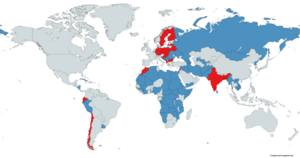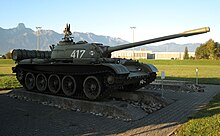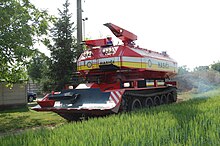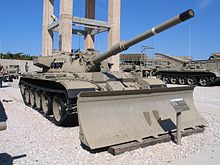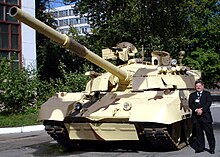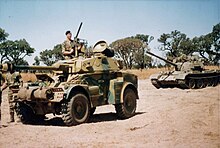
A military engineering vehicle is a vehicle built for construction work or for the transportation of combat engineers on the battlefield. These vehicles may be modified civilian equipment or purpose-built military vehicles. The first appearance of such vehicles coincided with the appearance of the first tanks, these vehicles were modified Mark V tanks for bridging and mine clearance. Modern military engineering vehicles are expected to fulfill numerous roles such as; bulldozer, crane, grader, excavator, dump truck, breaching vehicle, bridging vehicle, military ferry, amphibious crossing vehicle, and combat engineer section carrier.

The T-54 and T-55 tanks are a series of Soviet main battle tanks introduced in the years following the Second World War. The first T-54 prototype was completed at Nizhny Tagil by the end of 1945. From the late 1950s, the T-54 eventually became the main tank for armoured units of the Soviet Army, armies of the Warsaw Pact countries, and many others. T-54s and T-55s have been involved in many of the world's armed conflicts since their introduction in the second half of the 20th century.

The T-64 is a Soviet tank manufactured in Kharkiv, and designed by Alexander Morozov. The tank was introduced in the early 1960s. It was a more advanced counterpart to the T-62: the T-64 served in tank divisions, while the T-62 supported infantry in motor rifle divisions. It introduced a number of advanced features including composite armour, a compact engine and transmission, and a smoothbore 125-mm gun equipped with an autoloader to allow the crew to be reduced to three so the tank could be smaller and lighter. In spite of being armed and armoured like a heavy tank, the T-64 weighed only 38 tonnes.

The T-62 is a Soviet main battle tank that was first introduced in 1961. As a further development of the T-55 series, the T-62 retained many similar design elements of its predecessor including low profile and thick turret armour.
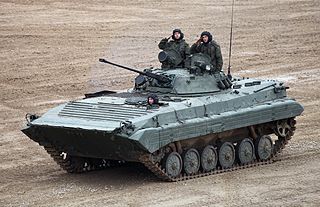
The BMP-2 is an amphibious infantry fighting vehicle introduced in the 1980s in the Soviet Union, following on from the BMP-1 of the 1960s.

The Centurion was the primary British Army main battle tank of the post-World War II period. Introduced in 1945, it is widely considered to be one of the most successful post-war tank designs, remaining in production into the 1960s, and seeing combat into the 1980s. The chassis was adapted for several other roles, and these variants have remained in service. It was a very popular tank with good armour, mobility, and a powerful main armament.

The PT-76 is a Soviet amphibious light tank that was introduced in the early 1950s and soon became the standard reconnaissance tank of the Soviet Army and the other Warsaw Pact armed forces. It was widely exported to other friendly states, like India, Indonesia, Iraq, Syria, North Korea and North Vietnam.

The Type 59 main battle tank is a Chinese-produced version of the Soviet T-54A tank, an early model of the ubiquitous T-54/55 series. The first vehicles were produced in 1958 and it was accepted into service in 1959, with serial production beginning in 1963. Over 10,000 of the tanks were produced by the time production ended in 1985 with approximately 5,500 serving with the Chinese armed forces. The tank formed the backbone of the Chinese People's Liberation Army armoured units until the early 2000s, with an estimated 5,000 of the later Type 59-I and Type 59-II variants in service in 2002.

The PT-91 Twardy is a Polish main battle tank. A development of the T-72M1, it entered service in 1995. The PT-91 was designed at the OBRUM and is produced by the Bumar Łabędy company, part of the Bumar Group, a Polish technical military consortium. Changes from the T-72M include a new dual-axis stabilized fire-control system, reactive armour, a more powerful engine, transmission and new automatic loader.

The Royal Ordnance L7, officially designated Gun, 105 mm, Tank, L7, is the basic model of the United Kingdom's most successful tank gun. It is a 105 mm L/52 rifled design by the Royal Ordnance Factories, intended for use in armoured fighting vehicles, replacing the older QF 20-pounder (84 mm) gun mounted on the British Centurion tank. The successful L7 gun has been fitted on many armoured vehicles, including the Centurion, the German Leopard 1 and, in an altered design, as the M68 gun in several variants of the US M48 Patton and M60.
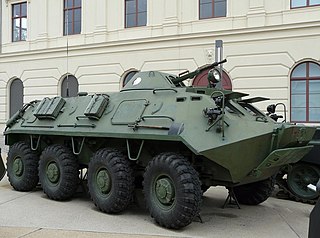
The BTR-60 is the first vehicle in a series of Soviet eight-wheeled armoured personnel carriers (APCs). It was developed in the late 1950s as a replacement for the BTR-152 and was seen in public for the first time in 1961. BTR stands for bronetransportyor.

The ZSU-57-2 Ob'yekt 500 is a Soviet self-propelled anti-aircraft gun (SPAAG), armed with two 57 mm autocannons. 'ZSU' stands for Zenitnaya Samokhodnaya Ustanovka, meaning "anti-aircraft self-propelled mount", '57' stands for the bore of the armament in millimetres and '2' stands for the number of gun barrels. It was the first Soviet mass-produced tracked SPAAG. In the USSR, it had the unofficial nickname Sparka, meaning "twin mount," referring to the twin autocannon with which the vehicle is armed.

The T-44 was a medium tank developed and produced near the end of World War II by the Soviet Union. It was the successor to the T-34, offering an improved ride and cross-country performance, along with much greater armor. Designed to be equipped with an 85 mm main gun, by the time it was fully tested the T-34 had also moved to this weapon. Both tanks offered similar performance, so introducing the T-44 was not considered as important as increasing T-34 production. Fewer than 2,000 T-44s were built, compared to about 58,000 T-34s. Although the T-44 was available by the end of the war, it was not used in any battle. It was 1 ton lighter than the T-34-85 and slightly faster. The T-44 was heavily influential on the design of the T-54/55 main battle tank, most prominently lower hull and turret profiles. Also notable was the T-44-100, a 100mm D-10T-armed prototype, which would be the same 100mm gun mounted on the T-54/55, bar some minor changes.

The BTR-50 is a Soviet tracked amphibious armored personnel carrier (APC) based on the PT-76 light tank chassis. The BTR-50 was developed in 1952 and entered service with the Soviet Army in 1954. It ceased production in the USSR in 1970, but production continued in Czechoslovakia until 1972 and there is suggestion that it still produced by some foreign companies. It has the ability to transport up to 20 fully equipped infantrymen, and can be armed with nothing, a 7.62 mm SGMB medium machine gun, or a 14.5 mm KPV heavy machine gun. It saw notable service in the Six-Day War, the Yom Kippur War, and most recently in the Russo-Ukrainian War.

The OT-64 SKOT is an amphibious armored personnel carrier (8x8), developed jointly by Polish People's Republic (PRL) and Czechoslovakia (ČSSR) well into the 1960s.

The T-72 is a Soviet-designed main battle tank that entered production in 1971. It replaced the T-54/55 series as the workhorse of Soviet tank forces. In front-line Russian service, T-72s are being upgraded or augmented by the T-90, itself a modernized version of the T-72B. The T-72 has been exported and produced in many countries.
This article deals with the history and development of tanks of the Soviet Union and its successor state, the Russian Federation; from their first use after World War I, into the interwar period, during World War II, the Cold War and modern era.

This article deals with the history of tanks employed by military forces in Czechoslovakia from the interwar period, and the more conventional tanks designed for the Czechoslovak Army before World War II, and the tanks that ended up as Panzers of the German Wehrmacht during World War II, or in the use of other countries who purchased them before the war began.

The history and development of the tank in North Korea spans the period from their adoption after World War II with the foundation of the Korean People's Army, into the Cold War and the present. Over this period North Korea has moved from being an operator of Soviet-designed and produced tanks to being the manufacturer of its own tanks.

